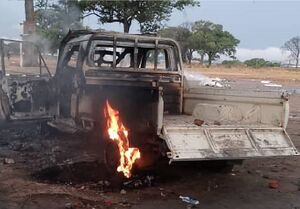2025 Chiwempala unrest
The 2025 Chiwempala unrest refers to a series of violent disturbances in the township of Chiwempala in Chingola District on the Copperbelt in Zambia, during 2025. Two major incidents — one in July and another in November — drew national attention and highlighted tensions in the mining sector, informal labour and community policing.
Background
Chiwempala is a township in Chingola, a major copper-mining town in Zambia’s Copperbelt Province. It has long been home to informal small-scale miners (commonly called “Jerabos”) who frequently clash with authorities over mining rights and access to pits. The area also suffers from high unemployment and economic fragility due to fluctuations in copper demand.
Incidents
July 2025: Riot by informal miners
On 30 July 2025, violence erupted after a group of informal miners were told to vacate the Senseli open-pit mine and subsequently marched into Chiwempala, Lulamba, and Mwaiseni townships where looting and destruction followed. Police reported that 79 suspects were arrested, one civilian — 22-year-old Bwalya Nsanda — was shot dead, seven police officers were injured, two earth-moving machines were torched, and several businesses looted.[1][2]
The government condemned the unrest and promised to deploy additional security forces while pledging to improve dialogue with community representatives.
November 2025: Riot and arson during presidential visit

On 8 November 2025, during a visit by President Hakainde Hichilema to Chiwempala Market, part of the crowd turned violent. Stones were thrown at the stage, shops were looted and a police Land Cruiser (registration ZP 2537 B) was overturned and set ablaze. Two suspects — Abraham Chilumbu (24) of Chiwempala and Abraham Sichone (21) of Mjomba Compound, Chingola South — were arrested.[3][4]
The incident overshadowed the President’s visit, which was intended to support traders affected by a previous market fire and exposed the growing frustration among residents over economic hardship and unemployment.
Causes
The unrest was attributed to several overlapping causes:
- Displacement of informal miners from pits without viable alternatives, leading to economic desperation.[5]
- Delays in formalising small-scale mining licences, leaving informal workers without legal access to resources.
- Destruction of livelihoods following a market fire that affected over 3,000 traders.
- High unemployment and limited youth opportunities in mining townships.
- Accusations of heavy-handed policing following the July fatality, which sparked community outrage.
Government and community response
Following the July violence, Copperbelt Province Minister Elisha Matambo visited Chingola and urged calm, calling for cooperation between authorities and local communities.[6] In the aftermath of the November incident, the police and the United Party for National Development leadership condemned the violence and warned that destruction of property and obstruction of state functions would not be tolerated. Increased police patrols were deployed across Chiwempala.
Community leaders, church organisations and business associations have since called for broader dialogue on mining reform, employment creation and more community-centred policing.
Impact and significance
The events in Chiwempala underscored the fragility of social stability in Zambia’s mining communities. The July fatality and the November violence during a presidential visit revealed how economic frustration, informal mining and political tension can converge to trigger unrest.
See also
References
- ↑ Authorities confirm 79 arrested, one shot dead as 7 police officers injured in Chingola riot, Zambia Monitor, 3 August 2025.
- ↑ Police Arrest 79 After Miners Clash with Officers in Chingola District, Open Zambia, 31 July 2025.
- ↑ Zambia Police Restore Order After Riot and Arson Disrupt President Hichilema’s Chingola Visit, Lusaka Times, 9 November 2025.
- ↑ Zambian President Hakainde Hichilema Pelted With Stones During Public Event, Pindula News, 9 November 2025.
- ↑ Chiwempala Stone Dealers Riot Over Denied Access to Pits, Zambia Reports, 3 April 2025.
- ↑ Copperbelt Minister Urges Calm as Authorities Respond to Chingola Riots, Lusaka Times, 2 August 2025.
